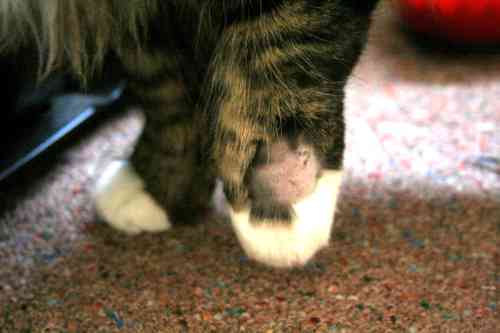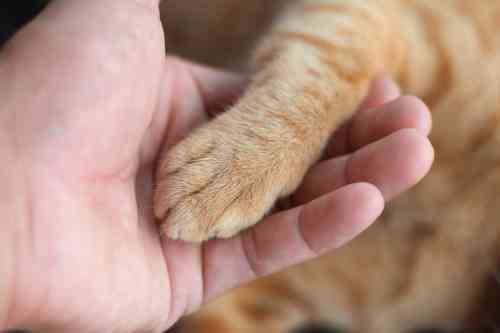Your cat has a growth on his paw
What to do now?
Fortunately, a growth on your cat’s paw is not very common. And if it does happen, it is usually a benign tumor or inflammation. So no big reason to panic. Some lumps on your cat’s paw will disappear on their own within a week. Does the growth on your cat’s paw remain for more than a week or does it bother him a lot? Then a vet visit is recommended. In this article we will tell you what might cause a growth on your cat’s paw and what you can do about it in that case.
What do we mean with a growth on your cat’s paw?
A growth, bump or tumor on your cat’s paw is clearly recognizable because it is generally a very local bump. You will almost always see a clear border between the normal part of the paw and the growth on your cat’s paw. They can be very small, about a few millimeters, but sometimes they are also a few centimeters in size. A true tumor usually does not grow overnight. Are you convinced that your cat didn’t have a growth on its paw 3 days ago? Then there is a good chance that his growth is a very painful abscess on your cat’s paw. They can sometimes also have a clear boundary. But an abscess is always much more painful than a growth on the paw. But also check carefully whether there are any ticks!
What could a growth on a cat’s paw be?
There can be several causes for a growth on your cat’s paw. Fortunately, cancer of a cat’s paw is not very common. In most cases there is a wart, but we also regularly see a cyst. Insect bites are also common, and sometimes a granuloma is present. As we said, it is also possible that an abscess is involved. But what we also often experience is that an owner comes to the consultation room to report that there is a tumor on his cat’s paw. However, it sometimes turns out to be a tick. It is not officially classified as tumors, but owners are often confused about them. Below we explain the various causes in more detail.
Cancer and benign tumors
Fortunately, cancer of a cat’s paw is relatively rare. Benign tumors are slightly more common, but still not very common. In both cases, new cells are produced somewhere on your cat’s paw where they shouldn’t be. This results in uncontrolled cell division. Normally, your cat’s body should stop cell division when it is not necessary, but unfortunately that functionality has broken down in this case. The result is that more and more tissue is created in that location. We call that a tumor.
But what distinguishes a benign from a malignant tumor? A malignant tumor is able to grow through other tissue and thus destroy an organ. In addition, some cells can often “loosen” and they can then wander through the body. Where they ultimately end up, they will form another tumor. In that case the tumor has metastasized. Benign tumors generally push other tissues to the side, but do not grow through them and at most destroy the other tissue by crushing it. In addition, benign tumors do not spread to other places. Apart from the fact that they can get in the way mechanically, they have no effect on your cat’s paw.
Wart
Actually, a wart is also officially a benign tumor. After all, it is an overgrowth of cells from the top layer of the skin. A wart on a cat’s paw usually looks a bit like a small cauliflower. There are often some lumps on the wart and it is bald. It is not painful and the skin normally looks calm and not red. Very occasionally it can become inflamed, causing it to become red and painful.
Cyst
If there is a cyst, the growth on your cat’s paw is a fluid- or sebum-filled cavity. The moisture or sebum made by the skin can no longer leave the gland through a normal (small) opening and then accumulates in the skin. Typically, they grow to about marble size over the course of a few months. They are not painful and usually do not bother your cat.
Insect sting
We often see an insect sting occur on a cat’s paw because they have been able to tease the wasp or bee with that paw. An insect sting is usually about 1 cm in size and can be somewhat tender, but not extremely painful. If you look very closely, you will see a small hole or scab in the center of the bump on your cat’s paw. It occurs from one moment to the next and usually disappears on its own after a week.
Granuloma
A granuloma is a skin thickening that occurs as a result of an inflammatory reaction. Immune cells (particularly white blood cells) will accumulate in that thickening and form an inflammatory response. The inflammation together with the immune cells can be recognized by a growth on your cat’s paw, usually on the soles of the feet. A granuloma occurs as a result of a foreign object, such as a splinter or small stone. But a bacteria or fungus can also be the cause. A granuloma is simply your cat’s body’s way of trapping an invader in its body so that it can no longer do any harm.
Eosonophilic granuloma complexes mainly occur in cats and are often caused by an allergic reaction.
What symptoms does a cat with a growth on its paw have?
- A bump or growth is visible
- In most cases, a growth on your cat’s paw is not too painful. If an inflammatory reaction has developed, it may be somewhat sensitive.
- The skin can sometimes have a different color such as red or very pale, and sometimes pigment formation is even visible
- Your cat may lick it a lot
- In case of mild pain, limping is possible.
- Sometimes the growth on your cat’s paw can develop bald skin
Treating a growth on your cat’s paw
Treat inflammation
If the bump actually appeared overnight and it doesn’t bother your cat much, then you can just look at it. Judge carefully whether it could be a tick by chance. You certainly wouldn’t be the first to run to the vet in panic with a tick. It is also wise to see if you see a small hole in the center of the bump. If this is the case, your cat has probably been stung by an insect. A bump as a result will disappear on its own after about a week.
Is the growth on your cat’s paw a little red or a little wet? Then there is an inflammatory reaction. In that case, it is wise to rub the growth on your cat’s paw with some honey ointment 3 times a day. After about 5 days, the growth on your cat’s paw should no longer be so red. Hopefully the tumor itself will have completely disappeared after that time.
Visit your veterinarian
If the growth has not disappeared after a week, it is wise to take your cat to the vet. Especially if your cat is a bit older. After all, it could be a tumor and, maybe, even cancer. So that must be ruled out. Your vet will puncture the bump with a needle and send the cells he removes to a laboratory. They will then tell you what the growth on your cat’s paw is and what the treatment options are. In many cases it will turn out that the bump can remain in place, unless it bothers your cat. However, if there is cancer, it will be advisable to have the growth on your cat’s leg removed. So better safe than sorry!
Preventing a growth on your cat’s paw
Preventing a growth on your cat’s paw is actually not possible. The only thing that can ensure that your cat is less likely to develop a growth on his paw is to feed him a high-quality diet and provide him with a good anti-parasitic treatment. Good hygiene of your cat’s living environment is also important. This means that the chance of ingesting toxic substances is much smaller. And take your cat to your vet regularly. They can notice much sooner than you when something is wrong with your cat. An annual physical check is certainly not an unnecessary luxury.
Good luck!
Hopefully the growth on your cat’s paw will disappear soon so you don’t have to worry about it anymore. But if that’s not the case, know that most growths on your cat’s paw are harmless. But you just want to be sure that it really isn’t cancer. Good luck and get well soon for your cat.





